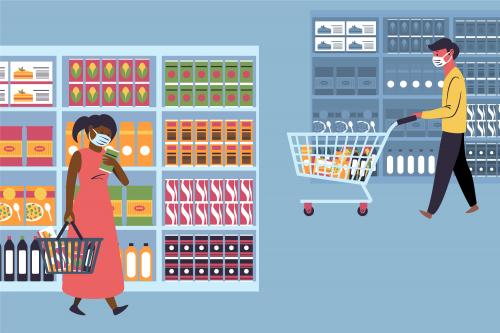In the last year, we have been able to flexibly adapt our research in order to react to the evolving COVID-19 situation. We collected data in both the early (first) ‘lockdown’ (May 2020) and then as the local restrictions in Aberdeen City began to be eased and schools went back after the summer break (‘post-lockdown’; August 2020).
All study participants completed 7-day diaries, documenting their consumption of foods and drinks over a week. The diaries were accompanied by short questionnaires addressing the frequency, timing, variety, healthiness, portion size, and social context of their meals, as well as related food purchasing and consumption behaviours. These issues were further explored in interviews with some participants to contextualise the data.
Pre-COVID food and drink diaries were also available for comparison for all participants, which enables us to explore the impact of the pandemic upon food habits. However, we also recognise that the relatively small number of participants means that findings, while quantitative in nature, may not allow strong conclusions to be drawn. Nevertheless, they do offer some interesting insight into our experiences and responses during this unprecedented period.
Food consumption – ‘eating-in’ during COVID restrictions
Participants were asked questions about their lockdown (May 2020) or post-lockdown (August 2020) purchasing and consumption of a range of food groups, choosing between ‘Decreased’, ‘Typical’, ‘Increased’ (all relative to pre-COVID) or ‘Do not buy/eat’. In almost every case, ‘Typical’ represented more than half the responses, indicating that changes in food habits for most participants were generally subtle modifications of existing patterns and behaviours rather than radical changes.
Analysis of lockdown questionnaires (May) suggested some movement towards lower fruit and vegetable consumption but increased consumption of frozen food, meat, and dairy, but less fish, compared to pre-COVID norms. Of the dietary starchy carbohydrates, consumption of potatoes and rice was largely unaffected, but pasta was reduced, whereas bread consumption was increased. When participants responded to the same questions in August, post-lockdown, they reported increased consumption of fruit, potatoes, bread, and pasta relative to their pre-COVID habits. An increase in alcohol consumption in lockdown was also largely reversed post-lockdown.
The social context within which food was consumed, and related factors such as timing and frequency were also addressed:
- Participants reported eating the traditional main meals of breakfast, lunch and dinner more frequently during lockdown than pre-COVID, with a greater variety of foods making up these meals.
- Breakfast was also consumed more frequently post-lockdown compared to pre-COVID, and a greater variety of foods were consumed for lunch and evening meal.
- Lockdown breakfasts and lunches tended to consist of larger portion sizes and post-lockdown breakfasts and lunches were consumed in the company of fewer people than pre-COVID.
- The frequency of snack consumption and the variety of foods eaten as snacks were increased at both census points compared to pre-COVID estimates.
- All meals and snacking events tended to be taken later in the day in both May and August 2020 compared to pre-COVID.
Purchasing and availability of food
In addition to the influence of environmental cues, dietary habits also require associated responses (behaviours) to be actionable. In this context, the types and varieties of foods consumed during the two census weeks will obviously have been influenced by food purchased, which, in turn will be influenced by availability of food in the shops.
Clearly, since March 2020, there have been periods, particularly early on, where the availability of certain foods – especially the long shelf life staples - was far from certain, so while some consumers stockpiled others had to go without. When questioned about food purchasing during lockdown, participants reported increases in bread, rice and potato (but not pasta) purchases, and of frozen and tinned food, meat and dairy, but decreased purchasing of fish. All these trends were normalised post-lockdown, when increased purchasing of fruit and vegetables was reported. The biggest increases in purchasing AND consumption during lockdown were for bread, dairy and frozen food (see bar chart).
Food types that showed the biggest increases in both purchasing and consumption during lockdown (May 2020). Participants were asked to choose, for a range of food types, between ‘decreased’, ‘typical’ or ‘increased’ relative to pre-COVID levels or could select ‘do not buy/eat’. Thus, for dairy purchasing, for example, all participants purchased dairy produce, with about 5% reporting a reduction compared to pre-COVID, 65% little change (‘typical’), and 30% an increase.
As the pandemic recovery stretches into 2021
We are grateful to our volunteers for allowing us to contact them several times over the last 12 months as the COVID-19 pandemic and associated restrictions have waxed and waned. We plan to maintain contact with participants as 2021 unfolds and, by repeatedly surveying our study group, build up a longitudinal picture of preserved and evolving dietary habits, and their resilience to shocks to the food supply chain.
Dr Dan Powell and Professor Julian Mercer, the Rowett Institute.
